 Whether it’s after a particularly bad day, to break a sad mood, or to disrupt a monotonous routine, there are times everyone needs to laugh. Laughter helps us relax and look at the comical parts of life. Books can play a key role at these times. They have the power to transport us outside of ourselves and our day-to-day lives, see the humor in our own beliefs and actions, and take life less seriously for a while. In this week’s book review column, members of the International Reading Association’s Children’s Literature and Reading Special Interest Group highlight books that challenge the realities we live with, from concern about what others think and say to fear and distrust of the unfamiliar to dealing with head lice, in comical ways that spark smiles and laughter.
Whether it’s after a particularly bad day, to break a sad mood, or to disrupt a monotonous routine, there are times everyone needs to laugh. Laughter helps us relax and look at the comical parts of life. Books can play a key role at these times. They have the power to transport us outside of ourselves and our day-to-day lives, see the humor in our own beliefs and actions, and take life less seriously for a while. In this week’s book review column, members of the International Reading Association’s Children’s Literature and Reading Special Interest Group highlight books that challenge the realities we live with, from concern about what others think and say to fear and distrust of the unfamiliar to dealing with head lice, in comical ways that spark smiles and laughter.
GRADES K-3
Escoffier, Michael. (2013). Brief thief. Illus. by Kris Di Giacomo. New York: Enchanted Lion Books.
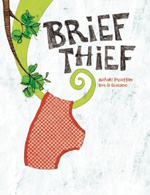 After having breakfast and sunning himself on a rock, Leon, a chameleon, has to “go poo.” He finds a tree and when he’s finished, discovers too late that there is no toilet paper left. All Leon can find at first are leaves and grass until he comes upon an old pair of red underpants “full of holes.” After using the underpants, Leon tosses them into the bushes and goes back to his rock. Before long, Leon’s “conscience” speaks to him because he touched someone else’s things. Leon realizes his conscience may be right, finds the underpants he tossed in the bush, and scrubs them clean. After hanging the clean underpants up to dry, Leon runs away. It is then that his “conscience” appears as an angry rabbit wearing a red cape and costume. The rabbit claims the underpants, puts them on his head (with his ears through the leg holes and other holes for his eyes) and flies away. This comical book is one everyone will enjoy.
After having breakfast and sunning himself on a rock, Leon, a chameleon, has to “go poo.” He finds a tree and when he’s finished, discovers too late that there is no toilet paper left. All Leon can find at first are leaves and grass until he comes upon an old pair of red underpants “full of holes.” After using the underpants, Leon tosses them into the bushes and goes back to his rock. Before long, Leon’s “conscience” speaks to him because he touched someone else’s things. Leon realizes his conscience may be right, finds the underpants he tossed in the bush, and scrubs them clean. After hanging the clean underpants up to dry, Leon runs away. It is then that his “conscience” appears as an angry rabbit wearing a red cape and costume. The rabbit claims the underpants, puts them on his head (with his ears through the leg holes and other holes for his eyes) and flies away. This comical book is one everyone will enjoy.
- Prisca Martens, Towson University, Towson, Maryland
Dumont, Jean-Francois. (2013). The chickens build a wall. Grand Rapids, MI: Eerdmans Books for Young Readers.
 When a hedgehog appears in the middle of the barnyard, the animals don’t know who he is or what to think. As they look more closely at him, the scared hedgehog curls into a ball. The next morning, when the hedgehog is gone, the animals get nervous. Where is he? Is he a thief? At the rooster’s suggestion, the chickens decide to build a wall around the henhouse to protect themselves. While the other animals watch, questioning the value of such a project, the hens spend the winter building a wall until it reaches far above the henhouse. As the chickens celebrate the completed wall, the hedgehog emerges from under the straw where he’s been sleeping. The hens and hedgehog get to know each other while the hens cut the door they’d forgotten to make. Before long, they’re not afraid of each other, the hedgehog stays, and the wall comes down. This story about becoming friends with others, even those who are different, and tearing down walls that separate is delightful.
When a hedgehog appears in the middle of the barnyard, the animals don’t know who he is or what to think. As they look more closely at him, the scared hedgehog curls into a ball. The next morning, when the hedgehog is gone, the animals get nervous. Where is he? Is he a thief? At the rooster’s suggestion, the chickens decide to build a wall around the henhouse to protect themselves. While the other animals watch, questioning the value of such a project, the hens spend the winter building a wall until it reaches far above the henhouse. As the chickens celebrate the completed wall, the hedgehog emerges from under the straw where he’s been sleeping. The hens and hedgehog get to know each other while the hens cut the door they’d forgotten to make. Before long, they’re not afraid of each other, the hedgehog stays, and the wall comes down. This story about becoming friends with others, even those who are different, and tearing down walls that separate is delightful.
- Prisca Martens, Towson University, Towson, Maryland
Gravett, Emily. (2013). Again! New York: Simon & Schuster.
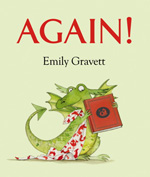 It's time for bed, and Cedric the dragon wants to hear a story. His mother reads Cedric his favorite book, the story of another dragon named Cedric who stays busy snatching princesses and tormenting trolls and has never in his life ever been to bed. When Mother finishes the story, Cedric politely asks, "Again?" Even though she's tired, Mother re-reads the book to each of Cedric's repeated requests, each time changing the text of the story in ways that encourage Cedric to go to sleep. When Mother falls asleep during a reading, wide-awake impatient Cedric turns red and roars loudly, “AGAIN!” over and over, burning a hole not only in his own book but also a die-cut hole through the book the reader is holding. The front endpapers show Cedric getting ready for bed and the back endpapers the princess and trolls trying to climb back into the story after falling out through the burned hole. The playful illustrations enhance the story and display the intensity of Cedric’s changing emotions. This delightful book will be one children want to hear “Again!” and often.
It's time for bed, and Cedric the dragon wants to hear a story. His mother reads Cedric his favorite book, the story of another dragon named Cedric who stays busy snatching princesses and tormenting trolls and has never in his life ever been to bed. When Mother finishes the story, Cedric politely asks, "Again?" Even though she's tired, Mother re-reads the book to each of Cedric's repeated requests, each time changing the text of the story in ways that encourage Cedric to go to sleep. When Mother falls asleep during a reading, wide-awake impatient Cedric turns red and roars loudly, “AGAIN!” over and over, burning a hole not only in his own book but also a die-cut hole through the book the reader is holding. The front endpapers show Cedric getting ready for bed and the back endpapers the princess and trolls trying to climb back into the story after falling out through the burned hole. The playful illustrations enhance the story and display the intensity of Cedric’s changing emotions. This delightful book will be one children want to hear “Again!” and often.
- Prisca Martens, Towson University, Towson, Maryland
Shannon, David. (2013). Bugs in my hair! New York: Blue Sky Press/Scholastic.
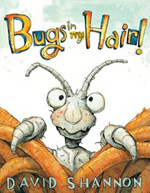 David Shannon takes on the embarrassing subject of head lice in his new book Bugs in My Hair. He tackles such topics as what lice are, how they spread, remedies for getting rid of them (the most powerful being Mom and her weapons), and how lice sometimes return. Facts, such as “Lice eggs are called ‘nits’ and “Dogs don’t get head lice”, are shared in comments marked with asterisks. The hilarious illustrations of the boy and his friends, his mom, and especially the lice themselves, including one who resembles Dracula and another named Bugzilla, add to the enjoyment. Shannon dedicated the book “To moms everywhere and their battle-tested anti-lice weapons.” This book is sure to have readers laughing…and itching!
David Shannon takes on the embarrassing subject of head lice in his new book Bugs in My Hair. He tackles such topics as what lice are, how they spread, remedies for getting rid of them (the most powerful being Mom and her weapons), and how lice sometimes return. Facts, such as “Lice eggs are called ‘nits’ and “Dogs don’t get head lice”, are shared in comments marked with asterisks. The hilarious illustrations of the boy and his friends, his mom, and especially the lice themselves, including one who resembles Dracula and another named Bugzilla, add to the enjoyment. Shannon dedicated the book “To moms everywhere and their battle-tested anti-lice weapons.” This book is sure to have readers laughing…and itching!
- Prisca Martens, Towson University, Towson, Maryland
GRADES 4-6
Krull, Kathleen, & Brewer, Paul. (2013). The Beatles were fab (and they were funny). Illus. by Stacy Innerst. New York: Harcourt.
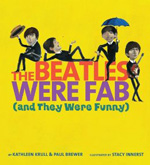 In this book Kathleen Krull and Paul Brewer take a look at the Beatles’ career, highlighting their sense of humor. Starting with the John, Paul, George, and Ringo forming a band and naming their group, the book chronicles their ups and downs, from their first days playing clubs in England and Germany for very little money to the height of their popularity to the time when they decided to separate. Funny things that happened along the way are shared, such as a policeman carrying Ringo over his shoulder to get him out of the crowd to safety; Paul saying, “no, no, no” to his father begging him to change the “yeah, yeah, yeah” line in “She Loves You” to “yes, yes, yes”; and, fans throwing jellybeans, the Beatles’ favorite candy, at the stage when they were performing. In addition, a full page is devoted to each band member and their best joke lines. The playful caricatures in the illustrations add to the fun of the book.
In this book Kathleen Krull and Paul Brewer take a look at the Beatles’ career, highlighting their sense of humor. Starting with the John, Paul, George, and Ringo forming a band and naming their group, the book chronicles their ups and downs, from their first days playing clubs in England and Germany for very little money to the height of their popularity to the time when they decided to separate. Funny things that happened along the way are shared, such as a policeman carrying Ringo over his shoulder to get him out of the crowd to safety; Paul saying, “no, no, no” to his father begging him to change the “yeah, yeah, yeah” line in “She Loves You” to “yes, yes, yes”; and, fans throwing jellybeans, the Beatles’ favorite candy, at the stage when they were performing. In addition, a full page is devoted to each band member and their best joke lines. The playful caricatures in the illustrations add to the fun of the book.
- Prisca Martens, Towson University, Towson, Maryland
Weulersse, Odile. (2013). Nasreddine. Illus. by Rebecca Dautremer. Grand Rapids, MI: Eerdmans Books for Young Readers.
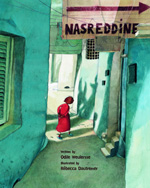 After Nasreddine helps his father Mustafa load a basket of dates on their donkey’s back, he walks behind the donkey, while his father rides, to the market in the city. Near the city gate someone comments about the lazy man who rides and makes his son walk. While Mustafa does not let the comment bother him, Nasreddine is embarrassed and goes home. In subsequent trips, Nasreddine responds to the criticisms he hears each time by, for example, arranging for Mustafa to walk while he rides and on another trip for them both to ride. After further criticism from others, Nasreddine suggests that he and Mustafa carry the donkey, at which point Mustafa explains that it’s a mistake to listen to everyone because people always find reasons to criticize. The message Nasreddine learns (“You can’t be afraid that other people will judge you or make fun of you”) comes through clearly in this charming book with Middle Eastern flavor.
After Nasreddine helps his father Mustafa load a basket of dates on their donkey’s back, he walks behind the donkey, while his father rides, to the market in the city. Near the city gate someone comments about the lazy man who rides and makes his son walk. While Mustafa does not let the comment bother him, Nasreddine is embarrassed and goes home. In subsequent trips, Nasreddine responds to the criticisms he hears each time by, for example, arranging for Mustafa to walk while he rides and on another trip for them both to ride. After further criticism from others, Nasreddine suggests that he and Mustafa carry the donkey, at which point Mustafa explains that it’s a mistake to listen to everyone because people always find reasons to criticize. The message Nasreddine learns (“You can’t be afraid that other people will judge you or make fun of you”) comes through clearly in this charming book with Middle Eastern flavor.
- Prisca Martens, Towson University, Towson, Maryland
GRADES 7-12
Freedman, Paula. (2013). My Basmati Bat Mitzvah. New York: Amulet.
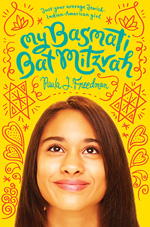 Tara (Hindi for “star”) Feinstein, a young girl who lives in New York with her Jewish father and Indian mother, is not only busy hanging out with her friends Ben-o and Rebecca and working on her robotics project, among other things, she’s attending study sessions with her rabbi in preparation for her upcoming Bat Mitzvah. In the midst of the everyday dramas in her life, which include dealing with the mini-catastrophes that accompany it, Tara begins to wonder about her cross-cultural identity, what it means to have a Bat Mitzvah, her faith, and how to balance her Jewish and Indian-Hindu identities. This coming-of-age story includes a little romance but primarily focuses on the themes of family and friendship. Tara is a fun, likeable character and readers will relate to her struggles, strength, vulnerability, and honesty. The book includes a glossary – Tara’s “Handy Hindi-Hebrew-Yiddish-English Vocabulary Guide (with a little bonus Punjabi)” – in the back.
Tara (Hindi for “star”) Feinstein, a young girl who lives in New York with her Jewish father and Indian mother, is not only busy hanging out with her friends Ben-o and Rebecca and working on her robotics project, among other things, she’s attending study sessions with her rabbi in preparation for her upcoming Bat Mitzvah. In the midst of the everyday dramas in her life, which include dealing with the mini-catastrophes that accompany it, Tara begins to wonder about her cross-cultural identity, what it means to have a Bat Mitzvah, her faith, and how to balance her Jewish and Indian-Hindu identities. This coming-of-age story includes a little romance but primarily focuses on the themes of family and friendship. Tara is a fun, likeable character and readers will relate to her struggles, strength, vulnerability, and honesty. The book includes a glossary – Tara’s “Handy Hindi-Hebrew-Yiddish-English Vocabulary Guide (with a little bonus Punjabi)” – in the back.
- Prisca Martens, Towson University, Towson, Maryland
Yolen, Jane, & Stemple, Heidi E. Y. (2013). Bad girls: Sirens, Jezebels, murderesses, thieves & other female villains. Illus. by Rebecca Guay. Watertown, MA: Charlesbridge.
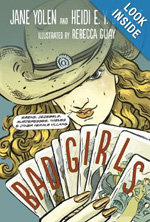 Delilah, Anne Boleyn, Bloody Mary, Catherine the Great, Calamity Jane, Mata Hari, Ma Barker, Typhoid Mary. These are some of the twenty-six infamous females mother-daughter team Jane Yolen and Heide Stemple present in this fascinating collection of short biographies. The authors provide a two-to-four page summary of each female’s life and exploits, accompanied by a portrait done by illustrator Rebecca Guay. Following each biography is a humorous one-page comic strip of Yolen and Stemple discussing whether the woman is guilty or innocent. The authors invite readers to reconsider any previous thoughts on the “bad girls,” showing there are two sides to every story. Are these females really “bad” or are they just misunderstood? What role did history itself play in our judgments of them? An extensive bibliography on her female at the end of the book points readers to where they can go for further information on each “bad girl.”
Delilah, Anne Boleyn, Bloody Mary, Catherine the Great, Calamity Jane, Mata Hari, Ma Barker, Typhoid Mary. These are some of the twenty-six infamous females mother-daughter team Jane Yolen and Heide Stemple present in this fascinating collection of short biographies. The authors provide a two-to-four page summary of each female’s life and exploits, accompanied by a portrait done by illustrator Rebecca Guay. Following each biography is a humorous one-page comic strip of Yolen and Stemple discussing whether the woman is guilty or innocent. The authors invite readers to reconsider any previous thoughts on the “bad girls,” showing there are two sides to every story. Are these females really “bad” or are they just misunderstood? What role did history itself play in our judgments of them? An extensive bibliography on her female at the end of the book points readers to where they can go for further information on each “bad girl.”
- Prisca Martens, Towson University, Towson, Maryland
These reviews are submitted by members of the International Reading Association's Children's Literature and Reading Special Interest Group (CL/R SIG) and are published weekly on Reading Today Online. The International Reading Association partners with the National Council of Teachers of English and Verizon Thinkfinity to produce ReadWriteThink.org, a website devoted to providing literacy instruction and interactive resources for grades K–12.